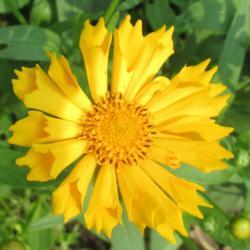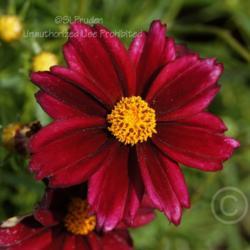This is one tough plant! It's in my "hellstrip" garden, about 12 square feet bordered by 2 concrete driveway aprons, the sidewalk, and the asphalt road. I watered that garden occasionally the first couple of years, and maybe if we hadn't had any rain for a few weeks. It blooms constantly! I hesitate to say "good for xeriscaping," because people think that means no watering ever. Most good xeriscaping plants still need water the first few years while they are establishing roots.

Coreopsis 'Moonbeam' is a selected form of the southeastern native, C. verticillata, which grows in dry, open woods. Two foot clumps are made of very finely dissected foliage giving the plant a delicate texture. Soft yellow daisy-like flowers appear from May to July and can be prolonged by occasionally shearing the spent flowers off. Grow the plant in full sun and average soil. Cut the whole clump to half its height in early May for an even more compact plant. It is neat and tidy and so well behaved that it was chosen to be the Perennial Plant Association's plant of the year for 1992.

Honey bees get nectar and pollen from this plant.

A showy wildflower in Illinois scattered throughout the state in dry prairies and sandy or rocky soils.

Coreopsis grandiflora 'Early Sunrise' is a 1989 All-America winner.

Honey bees get nectar and pollen from this plant.

The blooms of this low-growing Coreopsis are the most interesting shade of yellow. It is almost as if they pulsate with a tinge of orange, but I have never been able to capture this color accurately in a photograph. While they are stunning on their own, the blooms are even more amazing when paired with blue flowers, such as Centaurea.

Heavy clay soil. Planted at base of Just Joey and Opening Night roses. In shade much of the day. Might be why the flowers are much shorter than another JT in a different location of the yard?

This plant has a very open, airy form, with narrow leaves and a slightly sprawling habit. Each plant produces multiple blooms of dark cherry-red with golden centers.

With 'Creme Brulee' as its parent, 'Sienna Sunset' has 2" daisy-like flowers that are a light salmon/orange and lighten with age. Plants make tight 20" mounds of ferny foliage in full sun and average soil. They flower from mid-summer to early fall. Shear off spent flowers to really keep them going.
